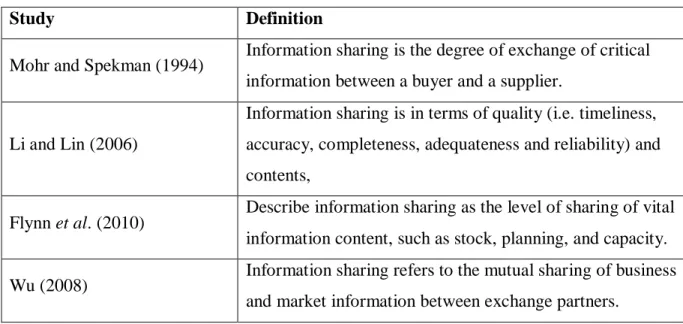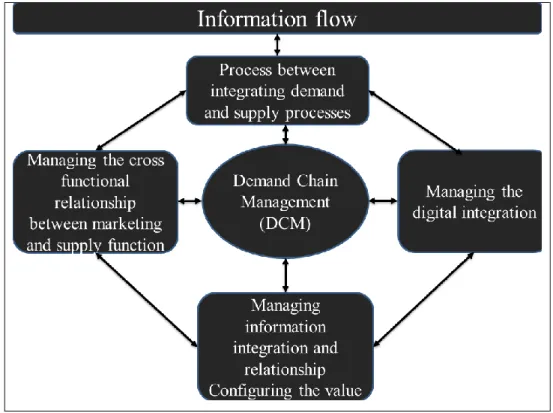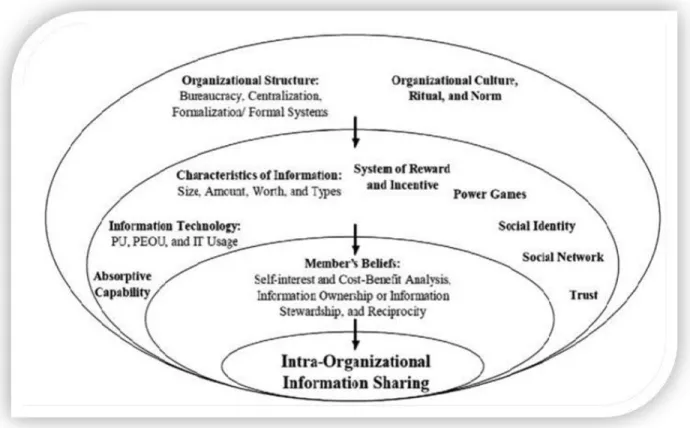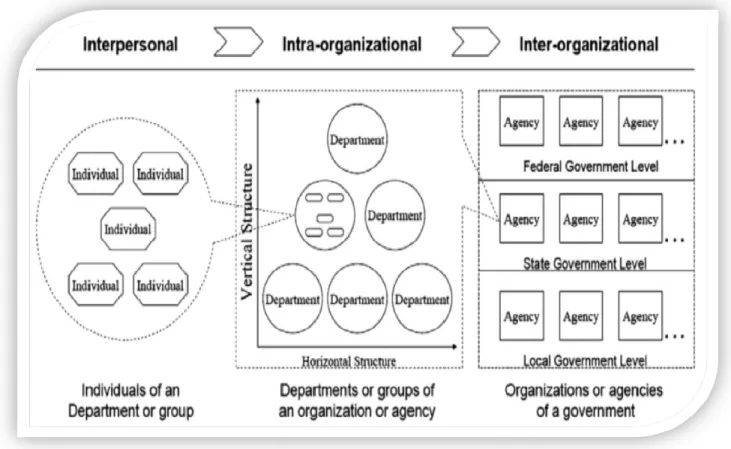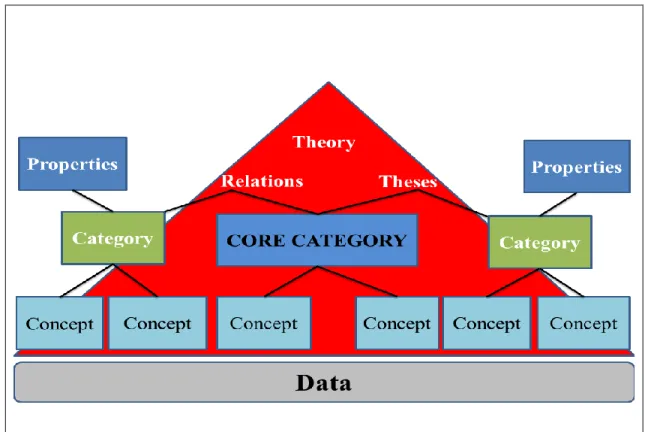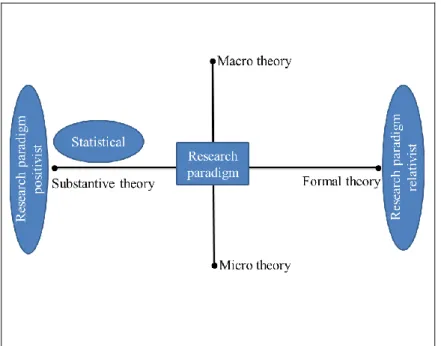The purpose of the study was to assess the management of information sharing in the order processing systems at DSA. The result of the study indicated that supply chain issues were department specific and it is recommended that information sharing and supply chain management are coherent in each department at Diplomat South Africa.
Introduction
In today's hyper-competitive global environment, organizations are beginning to recognize that delivering the best customer value at the lowest cost is not only related to the activities, functions and processes of the organization itself, but also to the entire supply chain (Koçoglu, Imamoglu, Ince, & Keskin, 2011 ; Jafarnejad et al., 2015). This study aims to examine the management of information sharing at Diplomat South Africa (DSA).
Background and Motivation of the Study
The sales representative may find out from the customer that the order has not been delivered, despite it being the delivery day specified by the customer, as stated by the operations department. Once this is done, the batch number of the order and the date of delivery to the Durban warehouse are communicated.
Problem Statement
Digitally based supply chain integration enhances clarity in the supply chain and reduces uncertainty arising from changes in orders and demand unpredictability. Diplomat global started operating in Israel in 1968 as a sales and distribution company in the FMCG industry.
Research Aim and Objectives
What improvement strategies for the management of information sharing in the order fulfillment system at DSA can be provided to create functional relationships between departments at DSA.
Preliminary literature review
Supply Chain Management
The Bullwhip Effect
Information Sharing
The Social Interdependence Theory
Research Methodology
Limitations of the study
Significance of the Study
However, a research gap remains to highlight the governance initiatives and implementation of information sharing, particularly in the private sector. In addition, the study provides recommendations for future information sharing management initiatives in the private sector.
Justification of the Study
Ethical considerations of the study
Dissertation Structure
This chapter reviews the relevant literature on assessing the management of information sharing in the order processing system at Diplomat South Africa. This chapter presents the data generated by conducting the study on assessing the management of information sharing in the order processing system at Diplomat South Africa.
Conclusion
Introduction
Supply Chain Management
Definition of Supply Chain
Supply chain management takes an integrated systems approach to the design, monitoring and control of the chain. Supply chain management also intends to reduce the costs and resources involved in the development of products as well as to increase efficiency and effectiveness (Weber, Hiete, Lauer and Rentz, 2010; Delgado and Mills, 2017).
Managing Information in the Supply Chain
Mohr and Spekman (1994) defined information sharing as the degree to which critical information is exchanged between a buyer and a supplier. Wu (2008) Information exchange refers to the mutual exchange of business and market information between exchange partners.
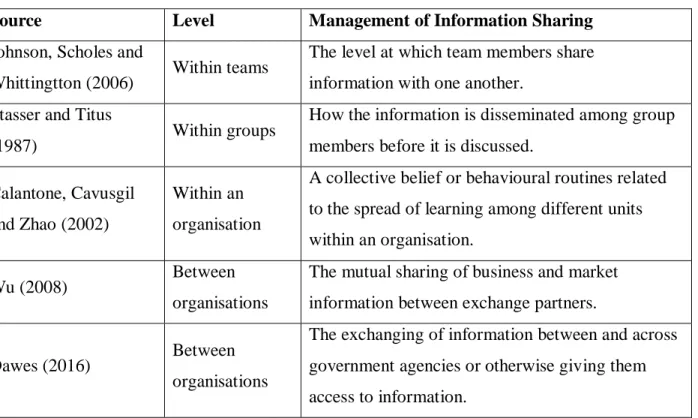
Understanding Management Information Sharing in Supply Chain
- Management
- Customer Relationship Management
- Customer Service Management
- Demand Chain Management
- Customer Order Fulfilment
- Procurement
- Management Functions
- Dimensions of Management Information Sharing
- Manufacturer-Key Suppliers Information Sharing
- Manufacturer-Key Buyers Information Sharing
For example, the future of information sharing objectives and actions to achieve results must be decided in the present. Studies have delved into upstream information sharing and downstream information sharing (Swink et al., 2007; Devaraj et al., 2007).
Information sharing in the supply chain
- Digital integration in the supply chain management system
- Internal supply chain processes
- Information integration and relationships with customers
- Cross functional relationships in the supply chain
It is an indication of the performance of each member of the SC, both internally and externally. Stock, Noel, and John (2000) and Bahinipati, Kanda, and Deshmukh (2009) agreed on the importance of the internal supply chain process contributing to the viability and productivity of SC execution.
Structural Concepts of Information Sharing
Development Chain Management
Collaborative Information Management
Bullwhip Effect
The absence of real-time information can greatly affect the efficiency and effectiveness of a supply chain. When an organization grasps the level of interdependence of each department on each other in the supply chain, the supply chain can only be improved.
Benefits of Information Sharing within a Supply Chain
Transparency within supply chain organizations enables managers to plan effectively, as well as respond appropriately to the correct information. Information sharing has been assessed as one of the most important methods for improving supply chain performance; it allows companies to improve the management of activities with other supply chain partners, which can result in better performance.
Drawbacks of Information Sharing in Supply Chain
The impact of information leakage in the supply chain has become more impactful with recent advances in Information Technology (Kim and Laskowski, 2016). One of the solutions to the negative impact of information leakage can be alleviated by using appropriate contracts between supply chain members.
Managing Information
- Levels of Information Sharing
- Inter-personal Information Sharing
- Intra-Organisational Information Sharing
- Inter-Organisational Information Sharing
- The Interrelation
To understand the management of information sharing in groups, the motivation sharing framework (Figure 2) was developed by Stasser and Titus in 1987 and revised by Wittenbaum and his colleagues (Wittenbaum, Hollingshead, & Botero, 2004). However, research has found that as a result of these hierarchical structures, the rate of information sharing is being negatively affected (Tsai, 2001; Baba, Wang, Adzani, & Abdul-Hamid, 2021).
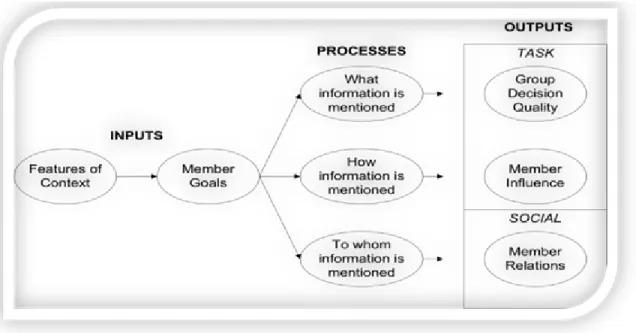
Resource-based View
In addition, a resource-based view has been used to analyze the complementary interactions between firms using inter-organizational information systems (Kim, 2006). However, a major shortcoming of the resource-based view is that it considers resources and capabilities only from the perspective of the firm, not the collaborative relationships.
Model Affecting Information Sharing
Individual Factors Influencing Information Sharing
It is important to note that individuals are the main drivers of information sharing in the organization and their state of mind towards information sharing influences their information sharing behavior. The current literature presents a variety of theories and models that speak to the individual factors that influence information sharing.
Technological Factors Influencing Information Sharing
Organisational Factors Inducing Information Sharing
In short, the availability of the necessary resources and organizational infrastructure encourages the sharing of information between employees in the workplace. Several studies show various factors that influence the sharing of organizational information, but Leopold, Pittke and Ahrend (2014) claim that four factors influence information sharing in the organization.
Information Sharing and Order Fulfilment Performance
Edwards, Nimako, Owusu-Manu, and Conway (2016) state that firms are expected to comply with customer order fulfillment even if it is difficult to do so. It is inevitable between different departments or project participants with certain specific tasks and domain knowledge as they interact to achieve their departmental goals as well as the inter-departmental group goals (Ojha et al., 2018).
Information Sharing and Inventory Management
The retailer stores information in a database daily and receives new order amount information from the analyst agent. The distributor stores and stores information in the database and receives updated information from the analyst agent for order quantity and replenishment time (Edwards et al., 2016).
Information Sharing, Production Planning and Management System
It starts taking orders from a retailer and, if there is enough inventory, the orders are fulfilled, if there is no stock, the orders change to a backlog. If faced with a backlog, the distribution agent orders the supplier to fulfill the retailer's requirements as new stock is obtained from upstream.
Information Sharing on Businesses Performance in the Supply Chain Process
However, it is often usual for delivery time to be shorter than the production period.
Bull Whip Effect and its Causes
- Demand forecast updating
- Order Batching
- Price fluctuations
- Rationing and Shortage of Gaming
Periodic ordering amplifies variability and contributes to the bullwhip effect by having demand spike at one point during the month followed by no demand for the rest of the month. When a price is reduced by discount deals and promotional activities, a customer buys in large quantities and when the product price goes back to normal price, the customer stops buying until it sells out the discount inventory.
Counteracting the Bullwhip effect
Order Batching
However, if the commission agent is waiting for a sufficient number of orders, the average time in the order system may be longer than planned. The efficiency of the picking process in such environments can be increased by serving a group of orders instead of individual orders.
Theoretical Framework: Social Interdependence Theory
The negative association is the point at which the view is that in the event that one of the individuals from the SC achieves its objective, the others can no longer fully achieve their objective (Jongman, 2017). While confused actions reduce the possibility of the individual to achieve his/her objective (Jongman, 2017).
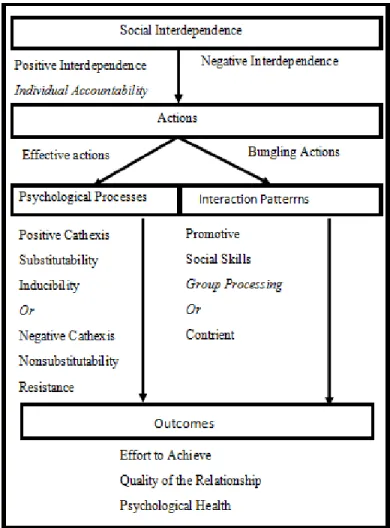
Conclusion
Attempting to improve individual SCs by ignoring the relationships and interdependence between chains may hinder proficiency elsewhere in the network, potentially prompting responses. Therefore, the interdependence between departments in an organization should be focused as part of SCM so that the SC can be fully optimized and function properly.
Introduction
Grounded Theory
Types of Ground Theory
The goal of GT, in the long term, is to get to more formal levels of theory. However, when a researcher develops a theory, their theory will apply to different fields and then become more formal and macro, but it doesn't have to be.
Research design
Research approach
It also enabled the researcher to draw a more holistic picture of what drives differences in information sharing in the organization and how it is linked to firm performance.
Target population
Sampling Design
Study Site
Diplomat Global operates in five countries around the world, namely Israel, Georgia, South Africa, Cyprus and New Zealand. Here in South Africa, Diplomat Global has five distribution centers in five provinces: Gauteng (Pretoria and Johannesburg), KwaZulu Natal (Durban), Free State (Bloemfontein), Eastern Cape (Port Elizabeth) and Western Cape (Cape Town). ).
Sample and sample size
However, some departments that were part of the study, such as Finance, Demand Planning and Masta Data, were located in the head office in Gauteng, Johannesburg. Of the total number of participants, 13% of them were from administration, 6% telesales order office, 19% credit control/finance department, 25% operations department, 6%.
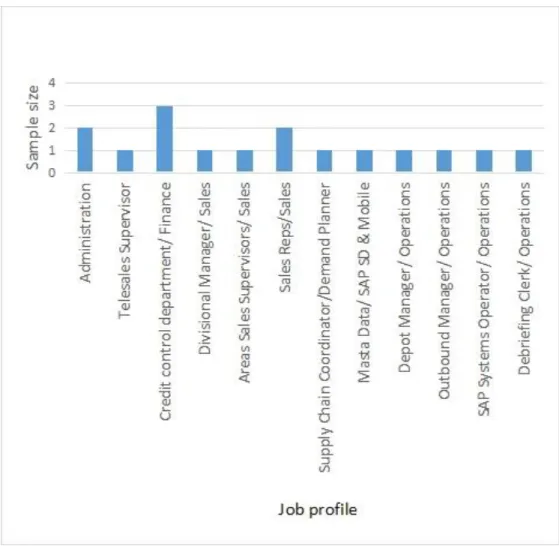
Ethical considerations
Data collection method
Interviews
Semi-structured interviews offer the possibility to arrange the order of questions and respondents can expand their ideas and talk in great detail about different topics, rather than relying only on concepts and questions that are defined in advance in the interview. Semi-structured interviews are fairly organized around the questions discussed during the interview, but further questions depend on the interviewer's opinions.
Justification for using interviews
In other words, semi-structured interviews are more flexible than standardized methods such as structured interviews. Then, the transcribed material was sent to the respondents, the statements were changed according to the comments of the respondents and finally, the material was approved by the interviewees.
Data Quality Control
Trustworthiness and credibility of data in qualitative research
Validity
Stability is also measured by the extent of the researcher's level of empathy and the extent to which the researcher reflects on her/his understanding of the issues of the participants (Gibbs, 2002; Dawadi et al., 2021). This is achieved by confirming that the findings of the study are not just the researcher's imagination.
Data analysis
Process of analysis
While reading the individual protocols, the researcher noted how the participants constructed the meaning of the concepts they were researching. Next, the researcher first reduced the data from the interview transcripts by extracting information relevant to the research questions.
Conclusion
The researcher used theoretical sampling to fill the gaps that develop in the emerging categories and concepts. The researcher went back and forth through the data verifying it with the participants, reading and analyzing it carefully until all the categories were fully developed and the relationships between the categories and their properties identified.
Introduction
Biographical Information of Sales Department
- Order Processing
- Individual Factors Affecting their Tasks: Challenges in Communication
- Proposed Improvement strategies
- Interdepartmental Communication
- Overall Performance and Productivity
- Capturing of orders
Some participants participate in the opening of new accounts, which is not related to order processing. Overall, most participants felt that there was a serious need to improve transparency between the departments involved in order processing.
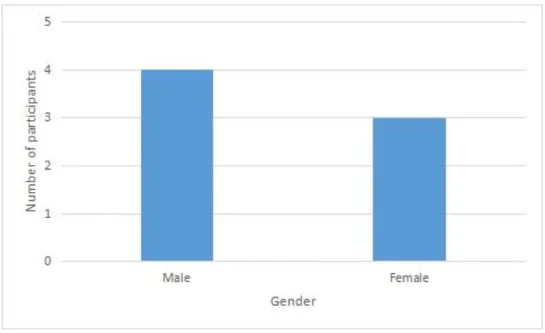
Biographical Information of Finance Department
- Authorisation
- Individual Factors Affecting their Tasks: Follow Up
- Key Strategies for Improvement
- Interdepartmental Communication
However, there are cases when they need authorization to perform certain functions, for example, if the amount of the order is too high, e.g. Two out of three participants (66%) linked their problems/errors/challenges in performing tasks in the system to waiting for the appropriate authorization.
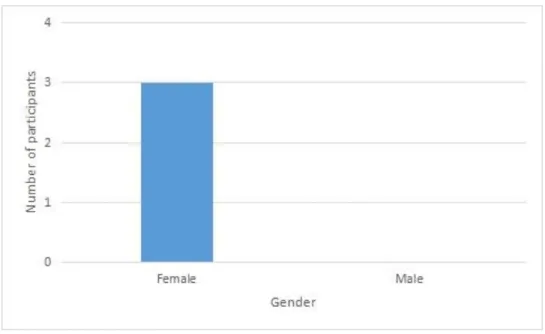
Biographical Information of Operations Department
- Order Processing
- Individual Factors Affecting their Tasks
- Key Strategies for Improvement
- Interdepartmental Communication
Participants here expressed that they are not involved in allocating inventory to an order while it is in the system, which is a function of the demand department. All participants in the operations department had problems/errors/challenges in performing their functions in order in the system.
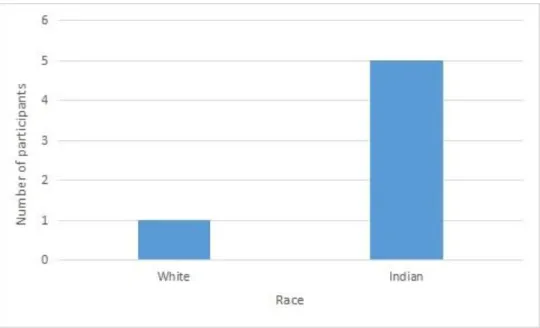
Biographical Information of Masta Data Department
- Individual Factors Affecting their Tasks
If the order was blocked from billing, we wouldn't choose it in the first place.” The participant from the Masta Data department was asked about the presence of any problems/glitches/challenges in performing functions in sequence on the system.
Thematic analysis
- Theme one: Digital integration in the supply chain management system
- Theme two: Internal supply chain processes
- Theme three: Information integration and relationships with customers
- Theme four: Cross functional relationships in the supply chain
We have to be aware in order to tell the customer when he will receive the order” (Interviewee 1). Finance should make the release and the rules should be changed in the future and looked at so that the release is much easier.
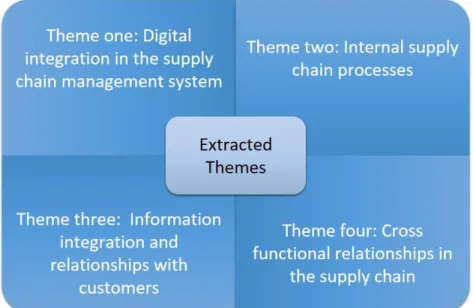
Conclusion
Introduction
The state of digital integration in the supply chain management system at DSA, focusing on
Inter-organizational information exchange involves adequate internal efforts for its progress (Baba et al., 2021). Effective implementation of ICT tools enables competent and successful exchange of information between employees.
The state of the current supply chain management on customer relationship management at DSA
- The department viewpoints
Active information sharing has become an indispensable instrument for the flourishing of supply chain management. Proposed improvement strategies for managing information sharing and establishing functional relationships between departments in DSA.
Proposed improvement strategies for the management of information sharing and creating
All participants (100%) within the operations department experienced problems/failures/challenges in performing their functions in sequence on the system. Individual issues related to managing information sharing in the order processing system at DSA were department dependent.
Conclusion
Several departments have emphasized the importance of communication, transparency and willingness to collaborate with other departments to improve the control of information sharing in the order processing system. They also emphasized the element of training in these processes and reporting and ensuring that these processes match each other to achieve a smooth flow of the order as it moves through the system.
Introduction
Summaries of each chapter
In this chapter, the order processing system has been outlined and the fundamental elements of the service delivery system have been discussed. Chapter four presents the qualitative dataset generated from the research questions.
Recommendations for improving information sharing at DSA
IT creates a platform for providing information related to the life cycle process (Cai et al. encourage the use of an electronic storage system that provides a database of information. An organized database allows for easy access, processing, retrieval and management of information (Cai et al. recommend the use of analytical tools to filter data for the decision making process.
Areas for further study
Limitations of the study
Contribution of this study to knowledge in supply chain management
Final Conclusion
Integration of internal supply chain management (SCM) towards long-term competitiveness (PhD thesis, Universiti Teknologi MARA).
APPENDIX A: DEFINITION OF TERMS
Capacity: According to Asiedu (2015), capacity is defined as the ability of an organization to function as a resilient, strategic and autonomous entity. Output: Output is defined as the final measurable results obtained upon successful completion of planned activities or completed tasks (Asiedu, 2015).
APPENDIX B: INTERVIEW GUIDE
12. Do you consider the customer's payment history/patterns before deciding to release or hold the order? 1. Once the sales representative captures and synchronizes the order on the system, capture the inventory and assign it to the purchase order as recorded.
APPENDIX C: INFORMED CONSENT FORM
Your participation in the survey is voluntary, and by participating you give the researcher permission to use your answers. All data, both electronic and paper, will be stored securely during the study and archived for 5 years.
APPENDIX D: APPENDIX F: ETHICAL CLEARANCE
APPENDIX E: EDITOR REPORT CERTIFICATE
